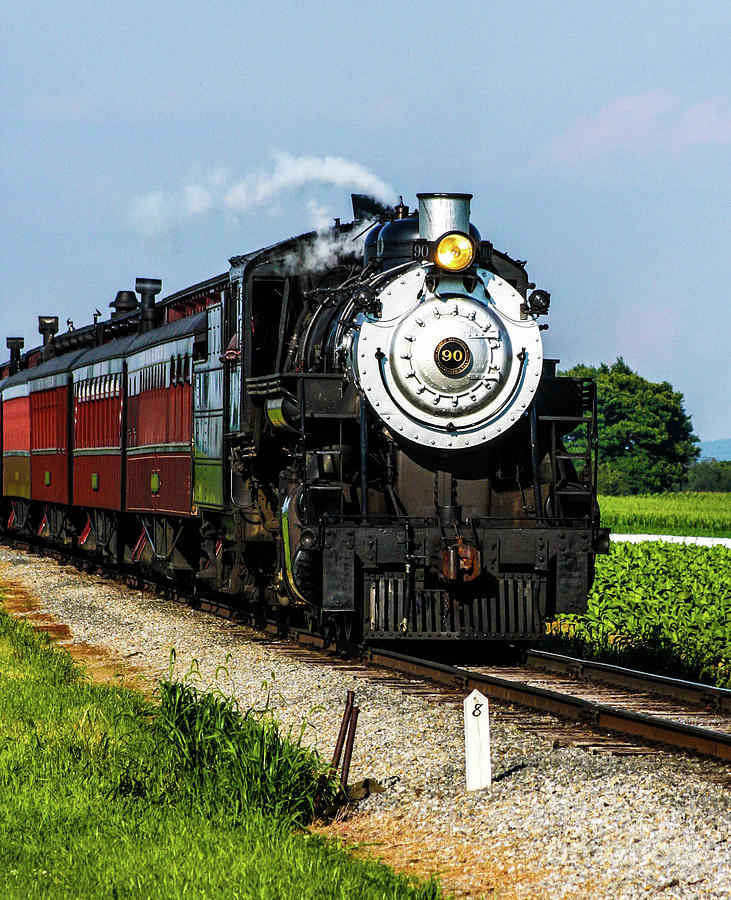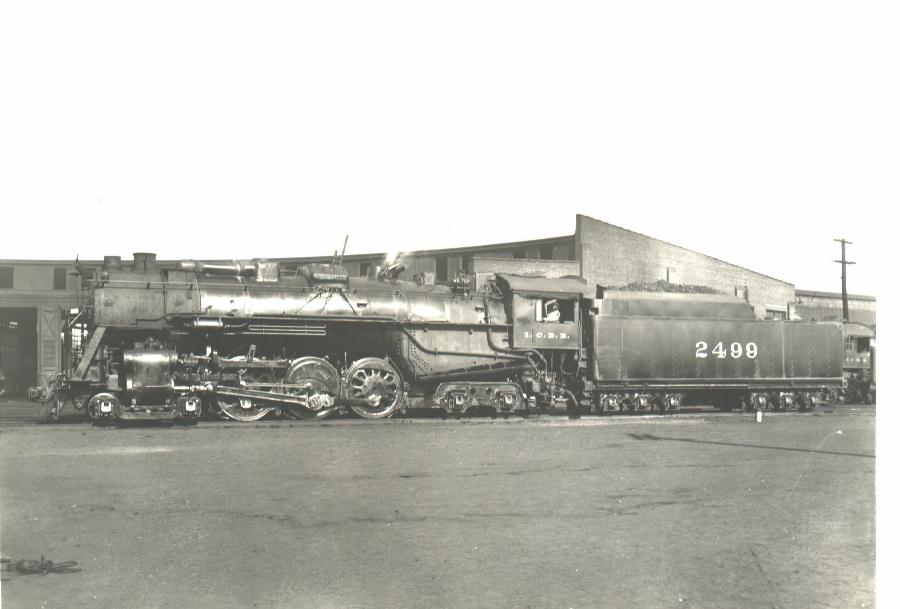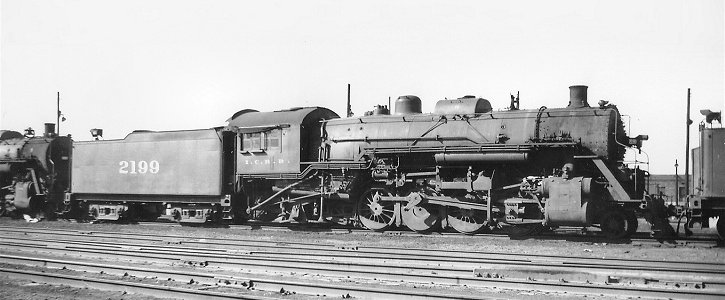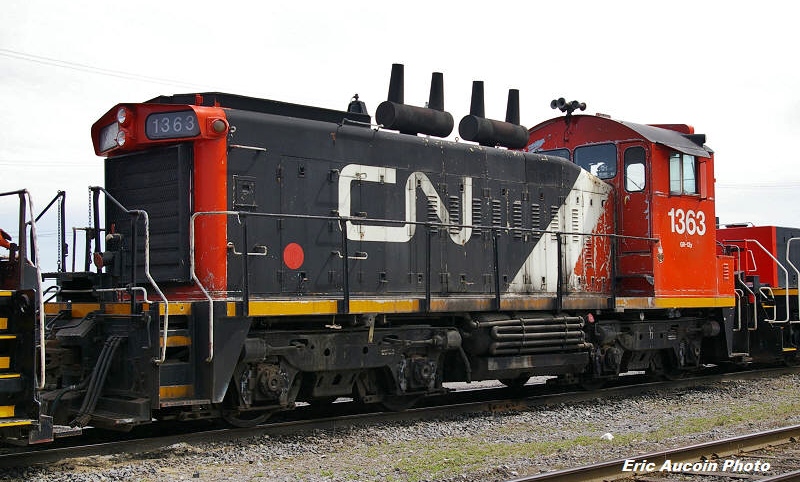Well, Strasburg Railroad announced that this summer they are running a program where you can be the engineer or fireman on one of their locomotives, or just ride in the jump seat up in the cab. I bought a ticket to operate Strasburg #90 on August 30th.

Mohawk, Adirondack & Northern C425 passes the old Owl Wire & Cable plant in Rome, NY. A lot of the MA&N's equipment wears the old British Columbia Rail two-tone green paint. The MA&N operates trackage right behind the Rome high school sports fields, and I remember when I was in school, we were outside for gym class and one of their C425s went by, the engineer notched up the throttle and it promptly fogged the whole sports field out with black smoke, as Alcos are known to do.

The "Alco smoke" that I referenced earlier. Unlike their competitors at EMD and Baldwin, who used supercharged and naturally aspirated 2-strokes, Alco was ahead of the curve, using turbocharged 4-stroke engines. This meant Alcos were better on fuel, as they made more power with less cylinders than their competition. It also meant that they "rolled coal" before people considered it cool. When an Alco was notched up, they typically blew plumes of black smoke until the turbocharger fully spooled up. This earned Alco's the nickname of "honorary steam engines."

Belt Railroad of Chicago's C424s seemed to be particularly smokey. That may have been due to lack of maintenance, as there are photos of their EMD switchers producing similar clouds of smoke, and EMDs typically just produced a light blue-gray haze.

An ex-Denver & Rio Grande Western F7 still wearing it's original yellow and silver livery, but with the Penn Central "mating worms" logo slapped on. In the '70s, the Penn purchased 10 retired D&RGW F7s for cheap to trade into GE for U-boats. Upon receiving them, Penn Central found that 4 of them were in reasonably good mechanical condition (and likely in better shape than most of PC's fleet), so they hastily relettered them and pressed them into service.

An ex-New York Central GP30 rests next to an ex-Pennsylvania N8 cabin car. The Penn Central might have been a wretched shambling end to three once-proud railroads, but it certainly did creat some interesting images.

The highest numbered locomotive on Penn Central's roster, #9999, was ironically it's smallest, lightest and least-powerful, as well as one of it's oldest. It was one of Pennsy's GE 44-ton switchers, the only one to make the transition from PRR to PC

PC #5158 was the only Fairbanks-Morse H16-44 from Pennsylvania to make the transition to PC, although there were also H16-44s from both the NYC and the New Haven on the roster. #5158 was also the only ex-PRR/ex-NYC H16-44 to get a Penn Central paint job (all 14 of the New Haven units got a repaint). The PRR and NYC units had the early styling that was more true to Raymond Loewy's design. The New Haven units were the later series, when Fairbanks-Morse began to water down the design, presumably for cost savings. Also odd, the #5158 was the only Penn Central unit to receive slanted cab numbers like that.

The "Dewitt Geep" was a fascinating Penn Central concoction. The PC had a large number of Alco RS3s that they inherited from all three railroads. They did like them because they were lightweight, had better visibility than a lot of their competition and had the good GE generators and traction motors. Plus, they were already paid for. But the Alco 244 engines were troublesome when new and were now headed for 30 years old, and Alco had shut their doors 3 years earlier.
Penn Central also had a large number of EMD E8 and E9 passenger locomotives, which had two 1200hp 567C V12s in each. Penn Central was beginning to wind down passenger operations (along with just about everyone else, due to lack of profit) and the E8 was not suited for freight use. So PC yanked the V12s out of their E8s and E9s and dropped a single V12 in an RS3. The process was done at their Dewitt, NY shops, and essentially created an EMD GP, so the nickname for them was a "Dewitt Geep" although Penn Central called them an "RS-3M". They were distinguishable by their humbacked long hood and tall conical exhaust stacks.
Despite a reduction of 400hp, they were still useful, as PC was mostly using them on branch line work or yard switching, so they didn't need the full horsepower of them. Conrail and Amtrak would end up with ownership in '76, and kept them in service for a while, with Amtrak running them on light commuter service and work trains. Even today, RS-3ms are still prowling around short lines and tourist railroads.

Norfolk Southern had another derailment yesterday, this time in Marysville, PA. Textbook "stringlining." This is the third or fourth stringline derailment they've had this year, all with center beam flat cars. Hurray, Precision Scheduled Railroading.

What is stringlining? Take a piece of string, lay it on a table and bend it into a curve. Now pull both ends. It pulls straight, right? Well, when you take a train and put the locomotives at the front, some heavy cars behind them, then a long cut of lightweight cars in the middle (centerbeam flatcars are the usual culprit) and then more heavy cars after them and send them through a few curves, the train wants to do the same thing as that string. So it rolls/pulls the center cars off the rails when they reach the center of the curve. When building a train, correct marshalling or homogenous consists are important to prevent this. But with crew cuts, equipment cuts, massive 2-mile long trains and minimizing switching by grouping cuts of cars together by destination instead of weight, operational procedures that are all hallmarks of Imprecision Scheduled Derailroading, string lining seems to be becoming more and more common.
In reply to 914Driver :
Wow, literally trains running through the front yard. Any idea where that was?
Edit: Doing the old "Search Google For Images" tells me that this was Oshawa in 1980. Looks like an SW1200 switcher.
I have to imagine the tracks were built after the house. I wonder if the railroad cut them a nice check every month, kinda like how phone companies pay you monthly for letting them build a cell tower on your property.
Illinois Central #1, the only 4-6-4 Hudson (at least in North America) that was built for freight service.

The Illinois Central was a notoriously thrifty railroad and loved rebuilding locomotives in their Paducah shops. Whether it was converting old 2-8-2s to 0-8-2 switchers, cutting up 2-10-0s to build 4-8-2s, converting old saturated steam locomotives to superheated or repeatedly overhauling GP-7s and GP-9s and keeping them on the roster until the 1990s, the IC did it all. But the IC was never a tinkerer. Their rebuilds all followed pretty conventional, proven lines of thought. They did not experiment with outlandish or unusual designs like the PRR. Well, except for once. And it proved that maybe there was a reason they weren't experiment-minded.
In 1937, Illinois Central was starting to move freight trains much faster. But they were too heavy for their Pacifics and their Mikados were much too slow. They had some 2-8-4 Berkshires for 1926, but these were not the same as the famous later, faster Berkshires that NKP, C&O and Pere Marquette made famous. These engines were pretty low speed, not by intention but by fundamental design flaws. Described by an engineer : "...rode poorly above 40 mph, sometimes so roughly that the reverse gear wheel would suddenly spin into full forward gear. When that happened the throttle had to be closed at once and the valve gear returned to the proper position -- and several engineers broke an arm doing so. The trailing truck also had a tendency to derail when backing up." The derailing issue was a notorious problem with Lima's odd articulated trailing truck.

So the IC came up with a plan to build a fast freight locomotive out of them. Since the engines would not be running fully loaded, they decided to cut out one drive wheel. And because they would be running faster, they did not feel confident in the single-axle lead truck's tracking ability and ability to control oscillation (an issue on engines with odd numbers of axles as they wanted to pivot around the center axle at speed). And they wanted a 2-axle trailing truck to support a big firebox. So they built a 4-6-4 out of Berkshire #7038, retaining the Berkshire's boiler, firebox, Lima articulated trailing axle and 27" diameter cylinders but with new 73.5" drivers. The lead truck was oddly outside-framed, which was not frequently seen. Trailing trucks were equally common in outside- and inside-framed but lead trucks were typically inside-framed.

Renumbered to #1, the new freight Hudson was put into service. And was found lacking. Between incorrectly set up spring-equalization that placed too much of the engine's weight on the lead and trailing trucks, and the fact that it still had the Berkshire's big 27" cylinders, it struggled with traction. To put it in car terms, this was the equivalent of the taking a 50/50-balanced, 600hp RWD car. Then you step down from 335 rear tires to 225. And then you shave off 500lbs but only over the rear axle, to give it a 70/30 weight distribution. But you keep the 600hp. Yeah. Not ideal. In '38/'39, the spring rigging was re-equalized to put more weight on the axles and they stepped down the cylinders to 24". This made it slightly more usable, but it never really performed as IC hoped. So instead, the IC rebuilt their #7000s, leaving them as Berkshires, but making a number of improvements. The #1 was renumbered to #2499 in 1945, as shown, and then later reassigned to passenger service between Louisville, KY and Fulton, KY. In '49, they retired the US's only freight 4-6-4 and cut it up for scrap.
Interestingly, the Berkshire that donated it's boiler and other parts to the #1, also donated it's frame to another unique one-of-a-kind IC engine. This was Mikado #2199. While all the other IC Mikes used 2-10-2 frames, the #2199 instead used the #7038's frame and 63" drive wheels, witha boiler off of 1914-built Mikado #1549. The unique hybrid Mikado lasted until the end of IC steam in '55 and was considered much more successful.

Also, at least as far back as '28, Lima had proposed a similar low-drivered 4-6-4 fast freight engine in an engineering paper, proposing Unitary Machinery Support, which was their idea of moving the cylinders in as close as possible to fight oscillation, nosing, hunting and imbalance hammer blows. This idea would lose out to lightweight materials with precision balancing. Also worth noting in that paper was a proposed 2-12-6 freight engine! Sadly, no one ever called up Lima and ever ordered any 2-12-6s, although they did build the 2-6-6-6s for C&O, which could be considered similar but articulated.

" Hey Mom, can we go out and play in the yard?"
"Sure. Make sure to put on your jacket and look out for trains."
T.J. said:" Hey Mom, can we go out and play in the yard?"
"Sure. Make sure to put on your jacket and look out for trains."
"Ope, just going to sneak through here quick. Sorry." - Canadian National
Haven't caught up at all, but took a minute to skim this page. There's something about locomotives that seems to encourage their being built in a way that just looks right, as a machine, an object, even architecture. There are some I like more, and some less, and there are duds, and how they get there changes, but on the whole there's usually something really satisfying about them.
Oddly, I think they might share something with motorcycles in terms of being exactly enough machinery to be the thing it is.
914Driver said:
this kind of thing fascinates me. i had to go look it up on google and found the location in the link below. The house and tracks are no longer there, but if you look down Bruce St you can still see the imprint of where the rails were.
https://goo.gl/maps/5EYq6f8ZX3GSSdsD6
ScottyB said:914Driver said:
this kind of thing fascinates me. i had to go look it up on google and found the location in the link below. The house and tracks are no longer there, but if you look down Bruce St you can still see the imprint of where the rails were.
https://goo.gl/maps/5EYq6f8ZX3GSSdsD6
I would have loved to live there!
I thought that that was an SW1200. I was incorrect. I was going off of the weird exhaust muffler/resonator/splitter/spark arrestor doohickeys that the SW1200s used.

And the SW8 did not.

Except that CN fitted them to their SW8s as well. Well, a single one of them, instead of the two on an SW1200
The number, 7179, is the giveaway, because the #7100 block was for SW8s, while the SW1200s were much lower numbered. Also, the SW1200 had the angled number boards with integrated headlamp, and the SW8s used the big trashcan headlamp with the numbers painted on the front. You can also see the roll-up storm front for blocking off the radiator in cold-weather operations.
You'll need to log in to post.